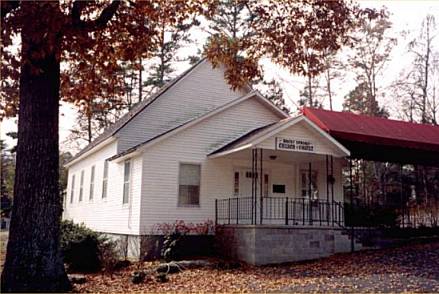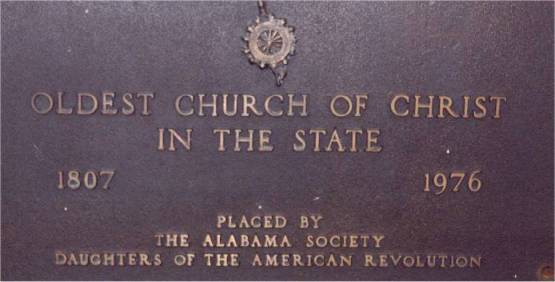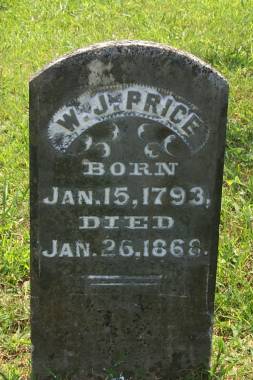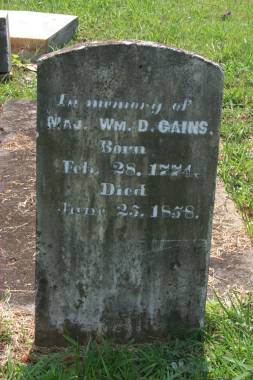Rocky Springs Church of Christ
The Oldest Continuous Church of Christ In Alabama


The Oldest Church of Christ In The State
1807-Present
Placed by
The Alabama Society
Daughters of the American Revolution
A Little Bit of History Of Rocky Springs
As you enter the Rocky Springs church building you will find a bronze plaque presented by the Alabama Society Daughters of the American Revolution stating that this is the "Oldest Church of Christ in the State."
According to old church records, life was quite different from ours today. There were dangers from hostile Indians, for this was Indian Territory. Cherokee Indians were abundant in the area as the Indian removal was not until 1828. It was said men of the church were posted outside of the building during services to guard against the Indians.
In the year 1807, Thomas Jefferson was President of the United States and we had slavery. There was no Jackson County, Alabama. Our new nation was only 31 years old. It was prior to the war of 1812. It is stated in the records of the congregation that valiant men served with honor in all wars of our country.
Early in the 1800's, a number of Presbyterian and Episcopalian pioneers had moved from North Carolina and Virginia into the Tennessee River Valley and adjoining areas of Tennessee, some of them founding a community in Warren County, Tennessee, which became known as Old Philadelphia. These were religious people, without a preacher, and they studied the scriptures together. Soon they were worshipping as one body, calling themselves Christians and the church only as the church of Christ.
A post road from Knoxville to New Orleans was opened in 1805 and some two years later, when the territory of Alabama, then largely occupied by Cherokee Indians, was opened to white settlers, among the first to arrive and settle in North Alabama was a group from Warren County, Tennessee. Some of these people located near the post road at the foot of Summerhouse Mountain and built a community called Antioch. This was in 1807.
Among these white settlers were William J. Price, who was baptized in 1811 at Old Philadelphia, Tennessee, his wife, and a slave named Moses. They selected a home site near a spring they found by following a game trail, and named the place Rocky Springs. It was a plantation located a little more than a mile south of Antioch. W. J. Price was a prominent leader in the church until his death in January 1868. His grave lies just across the street from the church building in the Rocky Springs cemetery.
A community grew up around the Price home on the post road to Rocky Springs. A post office, trading post, tavern and stables for changing horses on the stage coaches were all built here.
On June 12, 1847, the congregation moved into a new building at Rocky Springs and 82 members all committed themselves to the Lord. William Price had deeded the property to the church where, even to this day, it still stands. The records recognized the elders: Elisha M. Price, William King and Andrew Russell. In June 1851, the congregation had grown to 130 members. Deacons and elders were present in the church at this time.
The Civil War was most disastrous to the church. A letter written by Washington Bacon pointed out that there were ten widows and thirty-five children in the congregation and they were destitute. Many of the men of the church had been called to fight in the war, and most were killed. In the winter of 1864, the church building was burned by the Union Army.
Most of the remaining members were scattered, but some returned in 1865, resumed worship and slowly began to rebuild, completing the building in 1870.
By 1875, the congregation had outgrown the building and a larger one was constructed. The present building was erected in 1912, and additions have been made in the years since then.
As a point of information for those who mistakenly suggest that the church of Christ was founded by Alexander Campbell, it may be shown that Old Philadelphia church of Christ came into existence not later than 1810, that the Antioch (Rocky Springs) church began in 1807, that Campbell arrived in America September 29, 1809, and did not preach his first gospel sermon until July 15, 1810 at Washington, Pennsylvania. Campbell did not cease to work within association of the Baptist church until 1827. Thus, congregations of the church of Christ were in existence in America for at least 19 years before Campbell laid aside his denominational ties and began to worship according to the New Testament pattern.
Today, the Rocky Springs church is a small congregation, still striving to worship God in spirit and in truth and extending a warm hand of welcome to all.
-Contents taken from a brochure produced by the church of Christ at Rocky Springs.
Alabama's Oldest Church
Rocky Springs Church of Christ
(Originally Antioch Church of Christ)
Near Bridgeport, Alabama (Jackson County)
The following history of the Rocky Springs Church of Christ was compiled from documents now in the possession of Howard Blazer, Sr., from a history by Ralph Wharton (Unpublished), from an article by Ernest Clevenger, Sr., from information given by Lonnie Blackwell, and from examination of old church records now in the possession of Howard Blazer.
Early in the 1800's a number of Presbyterian and Episcopalian pioneers had moved from North Carolina and Virginia into the Tennessee River Valley and adjoining areas of Tennessee, some of them founding a community in Warren County, which became known as Old Philadelphia. These were religious people, without a preacher, and they studied the scriptures together. Soon they were worshipping as one body, calling themselves Christians and the church only as the church of Christ.
A post road from Knoxville to New Orleans was opened in 1805 and some two years later, when the territory of Alabama, then largely occupied by the Cherokee Indians was opened to white settlers, among the first to arrive and settle in Northern Alabama was a group from Warren County, Tennessee. Some of these people located near the post road and built a community which they called Antioch. This was in 1807.
Among these were William J. Price, baptized in 1811 at Old Philadelphia, Tenn., and his wife and a slave named Moses. They selected a home site near a spring they found by following a game trial, and named the place Rocky Springs. It was a little over a mile south of Antioch. W. J. Price was a prominent leader in the church until his death.
A grave stone marker in the Rocky Springs Cemetery has this inscription:
William J. Price
Born January 15, 1793
Died January 26, 1868.
A community grew up around the home of William J. Price, on the post road to Rocky Springs. A post office was established there, along with an Indian Trading Post, a tavern and stables for changing horses on the stagecoaches. On June 12, 1847, the congregation moved into a new building at Rocky Springs, abandoning the old one at Antioch. At that time there were eighty-two members, including six colored. Among the records is an item dated February 12, 1827, Jackson County, Alabama. It authorized James Anderson to preach the word of Truth and with the approbation of the congregation at Antioch, of which he was a member. It is signed by the elders, Elisha M. Price, William King and Andrew Russell.
In June 1851, according to a still extant copy of the minutes, the church listed 130 members of whom twenty-six were colored. Brothers Joel B. Arendale and Thomas A. Hill were appointed deacons. Brothers George Cloud and W. J. Hughes appointed bishops.
The Civil War was most disastrous to the church. A letter written in 1861 pointed out that there were ten widows with thirty-five children in the congregation, and that they were destitute. In the winter of 1864, the building was burned by the union Army. Most of the members were scattered. Some returned in 1865 and resumed worship, began slowly to rebuild, completing the building in 1870. By 1875, the church had outgrown the building and a still larger one was built. the present building was erected in 1912 and additions have been made since then.
When this writer began his investigations into the oldest congregation of the church in Alabama he did not know he would discover activities of distant relatives. Four brothers, Elisha, John, Hugh and William J. Price came from Ireland and settled in Asheville, N.C. Elisha was the eldest, being born in 1770. He died in 1876, two days after he reached his 106th birthday.
John Price died at the age of 110 and William lived to be more than 75 years old. Both Elisha and William were pioneer preachers of the church of Christ.
Hugh Price had six children: one son and five daughters. The son, Ed, was born June 24, 1824 (near Rossville, Ga.) and died June 16, 1910 at the age of 86. He was married to Mary Ernestine Armstrong (born Nov. 24, 1837 and died Dec. 11, 1912). The Rocky Springs church records have E. T. (Edward Thornton) Price and Mary E. [Armstrong) Price, his wife, listed ss members from 1884-88. Ed was the father of Hugh Armstrong Price, whose daughter, Myrtle Price Fridell, is the mother of Wary Ellen Fridell Clevenger, the writer's mother.
William J. Price and Elder Elisha Price are the 4th great uncles of the writer and Hugh rice, their brother, his 4th great-grandfather. Most of the information continued in this brief history was gathered from records now in the possession of Howard A. Blazer, Sr., who as stated, "I have the oldest records known of the Rocky Springs (formerly Antioch) congregation. The oldest authentic records in these books began with 1847."
It was W. J. Price who deeded the property to the Rocky Springs church for the church property and the cemetery, which is now the Rocky Springs Cemetery, where he is buried.
As a point of information for those who mistakenly suggest that the church of Christ was founded by Alexander Campbell it may be shown that Old Philadelphia church of Christ came into existence not later than 1810; that Rocky Springs (Antioch) Church of Christ began in 1807; that Campbell arrived in America September 29, 1809 and did not preach his first sermon until July 15, 1810 (At Washington, Penn.); and that Campbell did not cease to work within an association of the Baptist church until 1827, thus congregations of the church of Christ were in existence in America for at least nineteen years before Campbell laid aside his denominational ties and also began to worship according to the New Testament pattern.
It is believed that Rocky Springs Church of Christ is the oldest continuous New Testament church in America. Brother Blazer believes it to be the oldest congregation in the world which has been in continuous existence for 168 years and is still worshipping according to the New Testament pattern.
-Ernest J. Clevenger, Jr., Evangelist, Birmingham, Alabama, The World Evangelist, January, 1976, page 3.
Directions To Church Building
The Rocky Springs Church of Christ is located on Hwy 72, just southwest of South Pittsburgh, Tennessee, in the Alabama town of Bridgeport. In Southern Tennessee on I-40, take the Hwy. 72 exit at South Pittsburgh. Heading west on Hwy 72 (Also known as the old Cherokee, "Trail Of Tears") Just after crossing the Alabama line you will enter the city limits of Bridgeport. Continue past the exit for Bridgeport, and begin looking to your right for a sign, advertising Rocky Springs, the oldest Church of Christ in Alabama. Turn right and the church building will be on your left.
GPS Location
34.955384,-85.751211
Buried In The Cemetery Across The Street Are Some Of The Original Christians Who Followed The Cumberland Gap From Viola, Tennessee To Settle In Alabama Before She Became A State


Some of the early settlers who came down the Cumberland Gap who were instrumental in starting the church at Rocky Springs.
Preachers Buried At Rocky Springs
A. B. Blazer